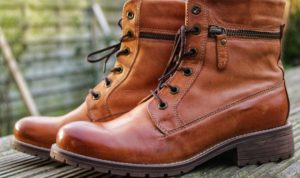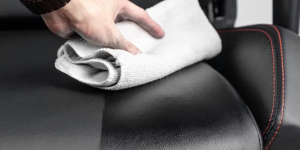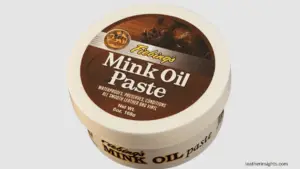5 Saddle Soap Alternatives for Leather (that WORK!)
Why should you consider choosing a saddle soap alternative for your leather?
Saddle soap has been used for decades to remove dirt, sweat, and oil from the surface of leather items. Unfortunately, this soap has been found to dry out the leather.
When you use too much saddle soap, you’re essentially stripping away the protective oils that have built up over time. This can leave the leather dry and susceptible to cracking and other damage.
So in this article, I am going to suggest some good saddle soap substitutes that you need to consider using to clean your leather shoes, boots, jackets, and even couches.

Is saddle soap good or bad for leather?
Leather is a natural material that needs to be taken care of in order to look and feel its best.
Saddle soap is a type of soap that is specifically designed to clean and condition leather. It does a great job of removing dirt, sweat, and grime, while also restoring leather color and natural oils that keep leather looking and feeling soft and smooth.
However, leather needs to be moisturized in order to stay supple and soft and saddle soap is not a very gentle moisturizer.
This soap contains harsh chemicals that can strip away the natural oils from the leather, leaving it dry and cracked. This happens if too much saddle soap is used too often on leather.
So you can prevent your leather from drying out by applying it sparingly on your items and occasionally.
Moreover, saddle soap is not suitable for delicate leather like suede as it can ruin the napped finish. Consider using a suede leather cleaner for delicate leather.
Does saddle soap waterproof leather?
No, saddle soap is a great way to clean leather, but it won’t waterproof it.
If you want to waterproof your leather, you’ll need to use a waterproofing spray or wax.
Applying a thin layer of beeswax to your leather goods will help to create a barrier against water and moisture.
You can also use a commercial leather waterproofing product, which you can find at most stores that sell shoe care products.
What saddle soap alternatives or substitutes can I use?
There are a variety of saddle soap alternatives that you can use to clean your leather saddles and other leather gear.
Saddle soap ingredients include cleaning agents and moisturizers and oils like lanolin, neatsfoot, glycerin, and wax polish among others.
If you don’t have saddle soap on hand, or if you’re looking for a more natural alternative do this;
Clean with a mild soap like dawn and then use good leather moisturizers or conditioners like mink oil and dubbin.
-
Dawn soap
If you are wondering whether they can use dawn soap on leather, the answer is yes.
Dawn soap is gentle enough to use on the leather without damaging it compared to saddle soap.
Simply create a solution of equal parts water and Dawn soap, and then use a soft cloth to clean the leather.
Rinse thoroughly with clean water afterward and dry with a soft towel.
-
White vinegar
White vinegar also works great on leather as a substitute for saddle soap.
It can be used to clean leather and remove grime, dirt, and stains and it is a lot cheaper than saddle soap.
However, if you are going to use vinegar on your leather, make sure that you dilute it with water first. This is because vinegar is acidic and can break down the leather over time and make it more brittle if it is used undiluted.
Once you have cleaned your leather with a mild soap alternative, consider using the following moisturizers.
-
Dubbin
Dubbin can be used in place of saddle soap to condition and moisturize the leather.
It’s a waxy substance that consists of natural fats and oils (often derived from animals). This combination helps to keep leather supple and prevents it from drying out or cracking.
Dubbin can be applied to a variety of leather goods, including shoes, saddles, and car interiors but not unfinished leather.
These days, however, it’s not as widely used as it once was.
-
Mink oil
Mink oil is a natural product that is derived from the fatty tissues of minks.
It is often used as a conditioner for leather goods and as a lubricant for metal surfaces.
Mink oil has numerous benefits that make it superior to saddle soap, including its ability to waterproof, protect against UV rays, and prevent drying and cracking.
The only downside to using mink oil is that it can darken your leather pieces if not used cautiously.
-
Glycerin
You can also use glycerin as a substitute for saddle soap. In fact, it’s quite a common ingredient in many saddle soaps.
Glycerin is a natural humectant, meaning it helps to keep moisture in the saddle soap and prevents the leather from drying out.
It also helps to protect the leather from stains and dirt.
Saddle soap vs leather conditioner
There are a few factors to consider when deciding whether to use saddle soap or leather conditioner on your leather goods.
Saddle soap is generally going to be a bit harsher on the leather, but it will also clean it more thoroughly. This makes it a good option for cleaning really dirty or neglected leather.
Leather conditioner, on the other hand, will be gentler and won’t clean as thoroughly. But it can help to restore moisture and protect the leather from further damage.
So, which one is better, saddle soap or leather conditioner? It really depends on what you need.
If your leather goods are very dirty, then saddle soap is probably the way to go. But if they just need a little TLC, then leather conditioner is probably the best option.
How do you make homemade saddle soap?
Saddle soap is one of those products that you can easily find a recipe for online, but it’s also something that you can easily buy at the store.
If you’re feeling adventurous (or if you just want to save some money), making your own saddle soap at home is actually pretty easy.
Here’s what you’ll need:
- 1/4 cup glycerin
- 1/4 cup grated castile soap (gentle cleanser)
- Baking soda or white vinegar (degreasing agent)
- 3 tablespoons distilled water
- 2 teaspoons neatsfoot oil
First, mix together glycerin, grated castile soap, and distilled water in a cooking pot and heat over medium heat.
Once the soap melts, add the oil and stir. Pour the solution into a glass container and let it cool before adding the lid. Once cooled, store in a cool place.
Can I use saddle soap on my leather couch?
Yes, you can definitely use saddle soap to clean your leather couch. In fact, it can be a great way to clean and protect your furniture.
Just be sure to follow the directions on the saddle soap package, and test it on a small area of the couch first to make sure it doesn’t damage the finish.
How to clean a saddle without saddle soap
You really don’t need saddle soap to clean a saddle – all you need is some warm water and mild detergent or soap.
Another option is to simply use warm water and a sponge. Gently scrub the saddle all over, paying special attention to any areas that look especially dirty or grimy. Rinse well with clean water when you’re done.
Also, you can clean a saddle using diluted vinegar. Mix one part vinegar with two parts water, and then proceed as above. The vinegar will help disinfect and clean the saddle without damaging it.
Whichever cleaner you choose, just make sure you rinse the saddle off thoroughly afterward so that no residue is left behind.
If you’re worried about damaging the leather, you can always test a small area first to make sure it’s not too harsh.
Conclusion
Some common alternatives to saddle soap include dawn soap and white vinegar. These can be combined with moisturizing oils like dubbin, mink oil, and glycerin.
Each of these ingredients has been shown to be effective at cleaning leather products without causing any damage.
In fact, some of these ingredients can actually help condition the leather and keep it looking new for longer.





